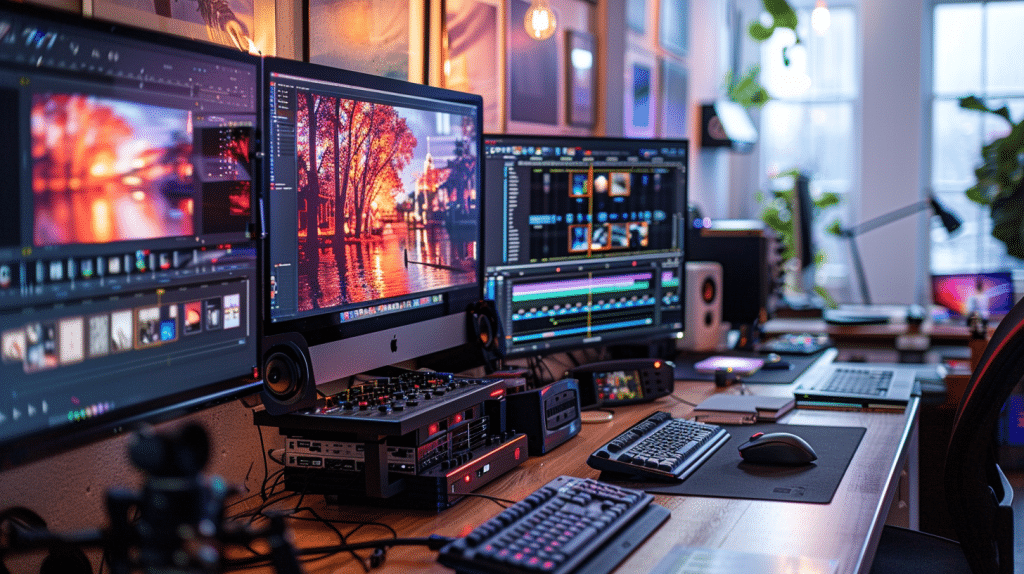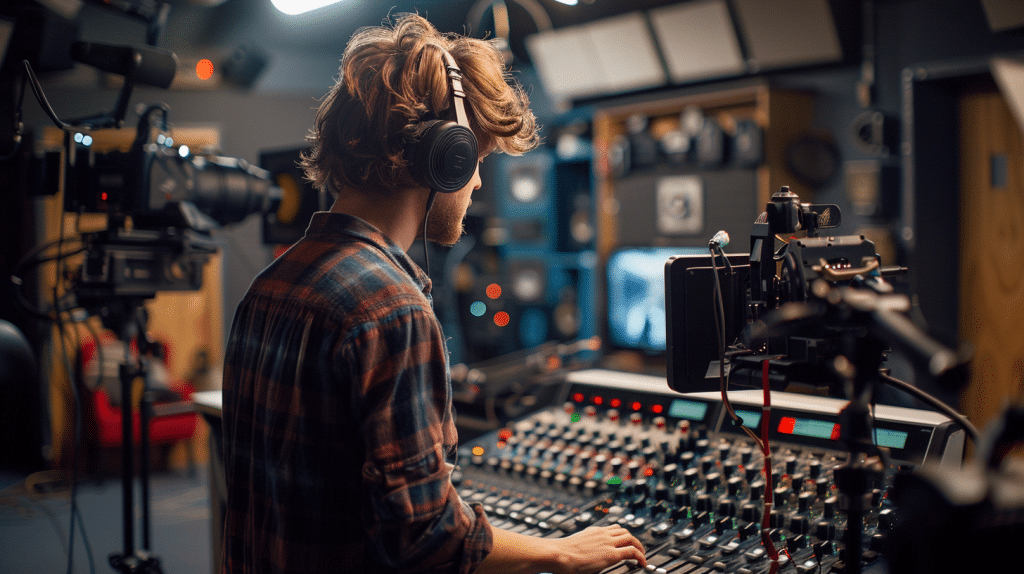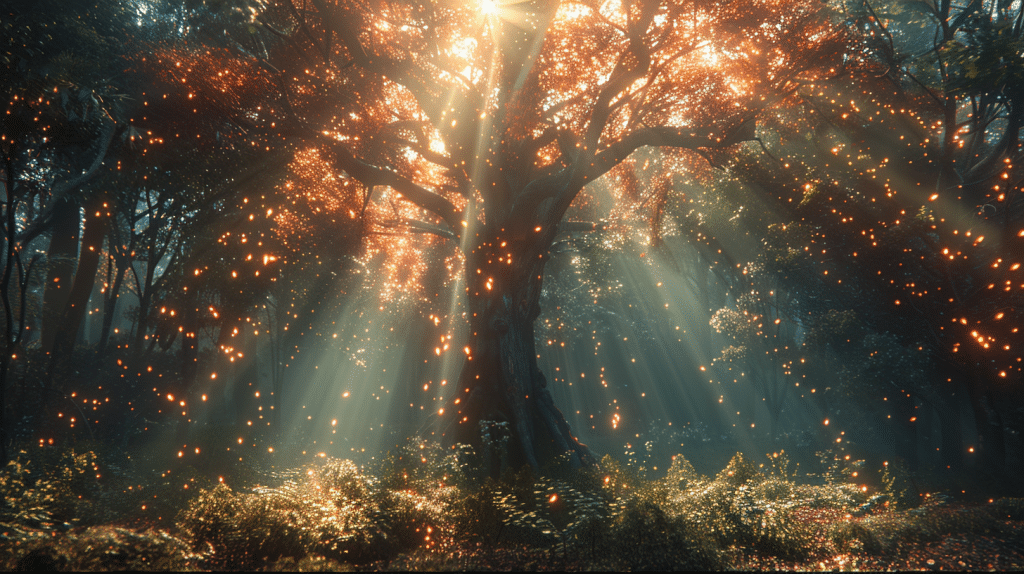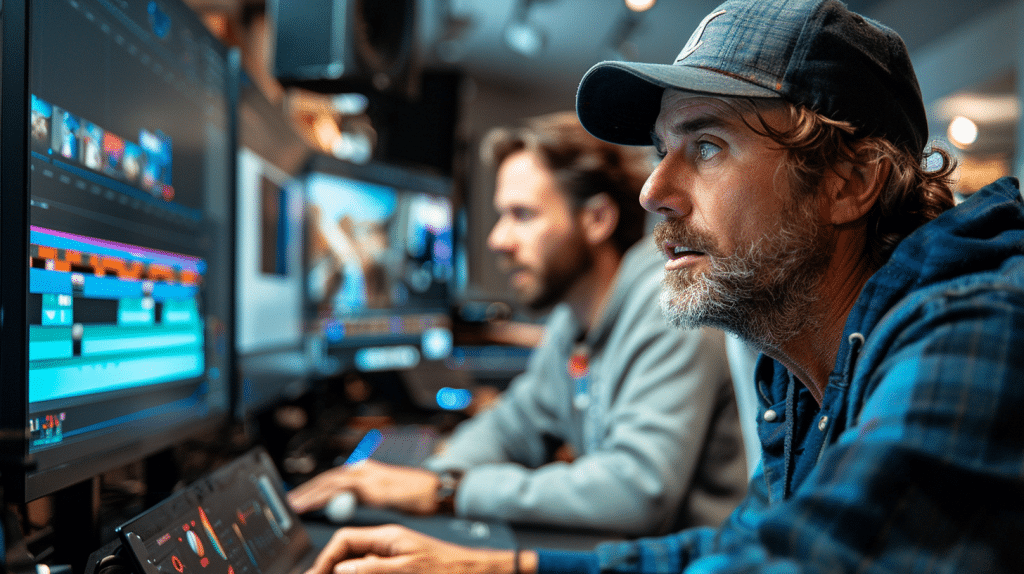Unveiling the Art of Post-Production: Transforming Raw Footage into Masterpieces

You may think that the filming phase is where the magic truly happens, but hold on a moment. Have you ever considered the intricate artistry that unfolds during post-production?
It’s not just about putting clips together; it’s a delicate dance of refining, polishing, and perfecting every frame to guarantee your vision comes to life in its full glory.
But what exactly makes post-production so vital to shaping the final outcome of your project?
Let’s explore this often underestimated domain of filmmaking and discover the hidden gems that lie within the editing bays and visual effects studios.
Table of Contents
The Role of Post-Production
Understanding the intricate process of post-production is essential for achieving a polished final product in any creative project.
This phase involves bringing together all the elements that were captured during production to create a cohesive and engaging piece. As you immerse yourself in post-production, you’ll find yourself engrossed in a world where raw footage transforms into a masterpiece through meticulous editing, sound design, color grading, and visual effects.
In post-production, you have the opportunity to shape the narrative, enhance the emotions, and captivate your audience by refining every detail. It’s a collaborative dance between creativity and technical skill, where decisions made at this stage can profoundly impact the overall quality of your project.
Embrace this phase as a playground for experimentation and innovation, where your vision truly comes to life.
Enhancing Visuals Through Editing

Exploring the art of editing enhances the visual appeal of your project, imbuing it with a vibrant energy that engages your audience’s attention.
Editing enables you to trim unnecessary footage, create smooth shifts, and improve the overall flow of your video. By thoughtfully selecting the finest shots and organizing them in a logical manner, you can effectively communicate your message and evoke the intended emotions in your viewers.
Through editing, you have the ability to control the tempo of your project, building tension, generating suspense, or delivering a punchline with accuracy. You can experiment with various editing techniques, such as cutaways, collages, or match cuts, to add depth to your visuals.
By rearranging the sequence of scenes, adjusting the pace of clips, and incorporating visual enhancements, you can elevate simple footage into a mesmerizing piece of art.
Importance of Color Grading

Immerse yourself in the transformative world of color grading and harness the full potential of your visuals with skillful precision.
Color grading plays a pivotal role in setting the mood, enhancing the atmosphere, and conveying emotions in your film or video project.
By adjusting colors, contrast, saturation, and brightness, you can create a cohesive visual style that captivates your audience and elevates the overall viewing experience.
With skillful color grading, you have the power to emphasize certain elements, create a specific ambiance, or even guide the viewer’s emotions without saying a word. Whether you aim for a warm and inviting tone or a cold and mysterious feel, the possibilities are endless when you master the art of color grading.
Moreover, color grading helps maintain consistency throughout your project, ensuring that every scene flows seamlessly into the next. It brings cohesion to disparate shots, unifying them under a consistent color palette that reinforces your storytelling.
So, embrace the art of color grading and watch as your visuals come to life with vibrancy and depth.
Elevating Sound Design

Sound design is the secret ingredient that can make or break the emotional connection of your audience to your story.
Imagine the rustle of leaves as tension builds, or the subtle hum of a city as your protagonist navigates through a bustling street.
These auditory elements have the power to transport viewers directly into the heart of your narrative, creating a rich tapestry of sensations that complement the visual feast before them.
Incorporating Visual Effects

To enhance the visual appeal and storytelling impact of your film or video project, consider integrating visual effects strategically throughout the post-production process.
Visual effects can elevate your project by adding layers of creativity and depth to your storytelling. Whether you’re aiming for a sci-fi futuristic look or a historical period piece, visual effects can transport your audience to the world you’ve envisioned.
Start by outlining the key moments where visual effects can make a significant impact. This could be enhancing a setting, adding dynamic elements to a scene, or creating fantastical creatures.
Collaborate closely with your visual effects team to make sure that the effects seamlessly blend into the narrative and enhance rather than overshadow the story.
Creating a Cohesive Narrative

Enhance your project’s impact by weaving a seamless narrative that captivates your audience and drives your story forward.
A cohesive narrative is vital in keeping viewers engaged and emotionally invested in your project.
Here are three key elements to ponder when crafting a cohesive narrative:
- Consistent Tone: Maintain a consistent tone throughout your project to guarantee a coherent storytelling experience. Whether it’s a light-hearted comedy or a dark thriller, the tone should be reflected in the dialogue, visuals, and music to create a unified atmosphere.
- Character Development: Develop your characters in a way that aligns with the overall story arc. Ensure that their actions, reactions, and growth contribute to the narrative’s progression and resonate with the audience on a deeper level.
- Narrative Structure: Pay attention to the structure of your story, including the beginning, middle, and end. Build a strong foundation, introduce conflicts that propel the plot forward, and resolve them in a satisfying conclusion that leaves a lasting impact on your audience.
Balancing Pace and Timing

Achieving a harmonious balance between pace and timing is essential for maintaining audience engagement throughout your project.
Imagine your audience as passengers on a thrilling rollercoaster ride; the pace determines how fast or slow they journey through the twists and turns of your story, while timing dictates when they experience the highs and lows.
To strike the perfect balance, consider the emotional impact you want to create in each scene. Are you building tension, delivering a punchline, or revealing a plot twist? Adjust the pace accordingly to enhance these moments.
Timing is equally vital; it’s not just about how long a scene lasts, but also when it occurs in relation to the overall story arc.
Think about the flow of your narrative—does a scene drag on past its peak, or does it end abruptly, leaving viewers confused?
Be mindful of when to cut to the next scene to maintain a cohesive and engaging storyline.
Perfecting the Final Cut

Perfecting the final cut in post-production is an essential step that elevates the overall quality and impact of your project.
Here are three key aspects to focus on when perfecting the final cut:
- Seamless Merges: Smooth merges between scenes or shots can greatly enhance the flow and coherence of your project. Pay attention to details like matching action or maintaining a consistent color palette to guarantee a seamless viewing experience.
- Audio Precision: Sound can make or break a scene. Make certain that the audio levels are balanced, dialogue is clear, and any music or sound effects are well-timed and add to the emotional impact of the visuals.
- Visual Cohesion: Consistency in color grading, visual effects, and overall aesthetics is vital for creating a polished final product. Ensure all elements work together harmoniously to convey the intended mood and message effectively.
Collaborating With Post-Production Team

When collaborating with your post-production team, establishing clear communication and a shared creative vision is essential for a successful project outcome.
Start by scheduling a kickoff meeting to align on project goals, timelines, and expectations. Encourage an open dialogue where everyone feels comfortable sharing ideas and feedback.
Throughout the post-production process, maintain regular check-ins to address any issues promptly. Be open to constructive criticism and willing to make adjustments as needed. Remember, collaboration is a two-way street, so value the expertise and insights of your team members.
Utilize project management tools to track progress, assign tasks, and streamline communication. This will help keep everyone on the same page and ensure that deadlines are met efficiently.
Foster a positive and respectful working environment to boost morale and productivity.
Investing in Quality Post-Production

Invest in high-quality post-production services to elevate the overall quality of your project and engage your audience with a polished final product.
When you invest in premium post-production, you’re ensuring that your content stands out and leaves a lasting impact on your viewers.
Here are three key reasons why investing in quality post-production is essential:
- Enhanced Visual Appeal: Quality post-production can elevate the visual appeal of your project, making it more interesting and professional-looking.
- Improved Storytelling: Post-production tools and techniques allow you to refine the narrative of your project, ensuring that your story is effectively communicated to your audience.
- Attention to Detail: Investing in quality post-production enables you to focus on the smallest details, such as color correction, sound editing, and visual effects, which collectively contribute to a seamless and engaging viewing experience.
Frequently Asked Questions

What is the significance of post-production in filmmaking?
Post-production is crucial because it transforms raw footage into a cohesive and polished final product.
This phase involves various processes like editing, sound design, color grading, and visual effects, which all contribute to shaping the narrative and enhancing the emotional impact of the project.
Without post-production, a film or video would lack the refinement and professional quality needed to engage and captivate the audience effectively. It’s during this stage that the true artistry of filmmaking comes to life, ensuring that the director’s vision is fully realized.
How does editing enhance the visual appeal of a project?
Editing plays a vital role in enhancing the visual appeal of a project by refining the raw footage into a seamless and engaging narrative.
Through techniques such as trimming unnecessary clips, creating smooth transitions, and adjusting the pacing, editors can emphasize key moments and maintain viewer interest. Editing also allows for the incorporation of various stylistic elements, such as cutaways and match cuts, which add depth and complexity to the visual storytelling.
By meticulously crafting each frame, editors ensure that the final product is not only visually appealing but also emotionally resonant.
Why is color grading important in post-production?
Color grading is important because it sets the mood and tone of the entire project, enhancing the visual storytelling.
By adjusting colors, contrast, and saturation, color grading can create a cohesive visual style that supports the narrative and evokes specific emotions in the audience. It ensures consistency across different scenes, making the project appear more polished and professional.
Additionally, color grading can highlight certain elements within a frame, guiding the viewer’s attention and reinforcing the director’s vision. Mastering this art form can significantly elevate the quality and impact of the final product.
What role does sound design play in post-production?
Sound design is essential in post-production as it adds an auditory dimension that significantly enhances the storytelling.
It involves the creation and integration of various sound elements, such as dialogue, sound effects, and background scores, which collectively build the atmosphere and emotional tone of the project. Good sound design can immerse the audience in the narrative, making scenes more realistic and impactful.
It can also manipulate the viewer’s perception, creating suspense, emphasizing dramatic moments, or providing subtle auditory cues that guide the audience’s attention. Overall, sound design is a powerful tool that can make or break the viewer’s emotional connection to the story.
How can visual effects be effectively integrated into a film?
Visual effects (VFX) can be effectively integrated into a film by ensuring they enhance rather than overshadow the narrative.
This starts with identifying key moments where VFX can add value, such as creating realistic environments, enhancing action sequences, or adding fantastical elements that are crucial to the story.
Collaboration with a skilled VFX team is essential to blend these effects seamlessly with live-action footage. Proper planning during the pre-production phase, including storyboarding and visualizing scenes with VFX, can help integrate them smoothly.
Additionally, maintaining a consistent visual style and quality throughout the film ensures that the effects support the storytelling without distracting the audience.
Share:
Search our blog:
Follow us on:
